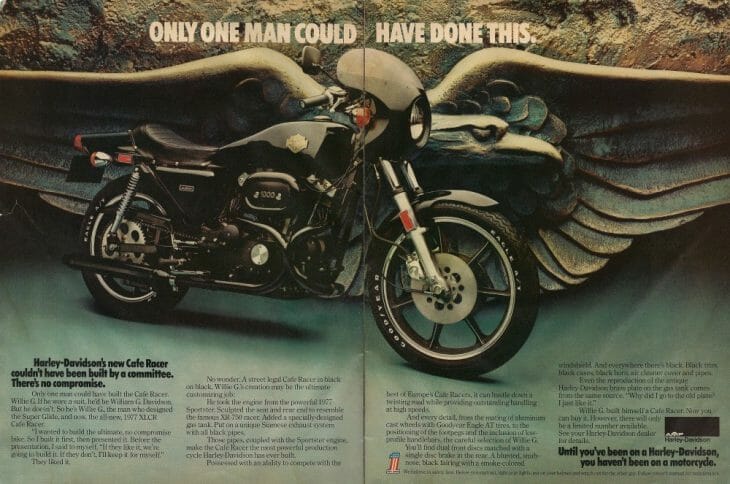Larry Lawrence | July 26, 2017

40 years ago, Harley-Davidson went off script. Milwaukee started with a clean sheet of paper and produced its interpretation of a café race with what would become a collector’s oddity, the 1977 Harley-Davidson XLCR. While utilizing the traditional 1,000cc XLCH Sportster powerplant, the XLCR was a unique American take on a sportbike. While the XLCR ultimately fell short in terms of sheer sporting performance and never sold in big numbers in its three-year production run, the motorcycle had a certain presence that won people over. It was black, bold, bad-mannered and uncompromising, in other words, all Harley.
The London biker hangout, the Ace Café, is said to be the birthplace of the café racer. The idea was to strip down and pump up a production BSA, Norton, Triumph or other sporting Brit bike, attach clubman handlebars, rearsets, stiffer suspension and, if you had the budget, add a Rickman or Seeley frame, then ride hell bent for leather from café to café.
By the 1970s the interpretation also began to often include a wider range of Japanese and European make, mostly sporting bikini fairings. It became a fairly sizable sub-culture of motorcycling and Harley-Davidson’s famous designer Willie G Davidson was said to be a fan of the genre and began to tinker around with building one of his own in the mid-1970s.
A small team at Harley-Davidson guided Willie G’s idea to fruition and developed the concept that resulted in the introduction of the XLCR in 1977. The XLCR made a bold statement with its blacked-out engine cases and cylinder fins, black paint scheme, which included a small fairing, a longish solo saddle and a unique Siamese black exhaust system with a booming exhaust note, all rolling on a sweet-looking set of Morris mag wheels – black of course.
The XLCR was the fastest production Harley-Davidson made to that point, and it would stay that way until the XR1000 was released six years later.
The XLCR was capable, in the right hands of just breaking into the high 12-second quarter-mile, 100 mph times. While not bad, it was still a full second slower than its 11-second street burning contemporaries like the Yamaha XS1100, Suzuki GS1000, Honda CBX and Kawasaki Z1-R (the bike you might say was the Japanese equivalent of the XLCR).
Testers of the day lauded the XLCR’s torquey cast-iron, 45-degree, 997cc pushrod engine. Not the quick hyper rush of speed that something like the XS1100 delivered, the XLCR’s mill simply pumped out a steady building surge of power, accompanied by the ever-increasingly loud mechanical drumbeat of the big V-twin. The broad powerband of the Harley allowed riders to focus on the road ahead and their cornering technique, instead of constant shifting to make sure the engine is in the powerband.
Brakes were a weak spot for the XLCR. When dry the big triple discs were touchy, weak at first and then prone to lock up under heavy pressure, but if a rider was unlucky enough to get caught in the rain he could only hope the traffic-light gods were with him.
The XLCR was only produced for three years (1977-1979) and only a little over 3000 machines were built. Very few, if any, ever saw the race track. The very fact that Willie G’s statement bike was built during the conservative AMF era was a major accomplishment in itself.
Perhaps the timing of the motorcycle was wrong. Harley faithful were mostly interested in Sportsters or the company’s bigger touring machines, while sportbike enthusiasts of the era were attracted to the higher performance and greater refinement of the Japanese and European sporting machines of late 1970s.
In spite of all this, the XLCR gained a hardcore following and later became a fairly desirable collectable. A motorcycle that sold for $3600 in 1977 could fetch five times or more that today. One 1977 model sold recently at a Mecum Auction for $23,500.
The fact that Harley-Davidson didn’t build anything remotely like the XLCR for over 30 years, some say until the launch of the XR1200 in 2008, makes it an important and certainly unique motorcycle in the history of the Motor Company.
As it stands today, the XLCR is considered a desirable, charismatic 40-year-old machine that is striking to the eye and exciting to ride. You can’t ask for much more than that from a sporting motorcycle of that era.
Perhaps Cycle World put it best in summarizing the XLCR during its test in May of 1977 – “As a motorcycle, the XLCR has not much merit. As an adventure, the XLCR has no equal.”